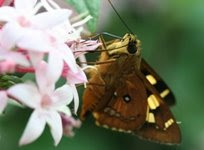A stunning butterfly that emerged from its chrysalis as male on one side, female on the other, has astounded curators at the Natural History Museum in London. The peculiar nature of the freshly hatched great mormon butterfly was spotted when staff noticed a striking difference between its wing colourings and other features. The insect, which has a 10cm wingspan, is almost black on its male side, but the female side is much paler, with clearly visible flecks of blue, red and tortoiseshell. A closer inspection revealed the insect to have one antenna longer than the other, a single male clasp on its abdomen, and male and female reproductive organs that had fused down the middle. The butterfly hatched two weeks ago during the Sensational Butterflies exhibition that runs at the museum until September. "It's an amazing butterfly. The split is purely bilateral – even the colour of one side of its body is slightly different," said Luke Brown, manager of Sensational Butterflies. "It has half-male, half-female sexual organs welded together. So they don't work, it is infertile."
Insects can be born gynandromorphs – with male and female cells – when sex chromosomes fail properly to separate when the fertilised egg divides. Around one in ten thousand butterflies is a gynandromorph. Many dual-sex butterflies probably go unnoticed, because the males and females look alike. Brown, who has seen only two other gynandromorphs in his career, said the butterfly was feeding and flying well, and was expected to have a normal life expectancy of around one month. The specimen will become part of the museum's lepidoptera collection. In 2008, a half-male, half-female moth emerged at the museum. The insect had one bright yellow wing and another that looked brown and dusty. Crabs and lobsters can also be gynandromorphs. Blanca Huertas, curator of butterflies at the museum, said: "The gynandromorph butterfly is a fascinating scientific phenomenon, and is the product of complex evolutionary processes. It is fantastic to have discovered one hatching on museum grounds, particularly as they are so rare.' *Guardian
Monday, September 5, 2011
New Butterfly Species Found
Butterflies
Butterfly Conservation Ireland are reporting that, following a new study of wood white butterflies in Ireland and other parts of Europe, a new ‘cryptic' species of Wood white has been identified by DNA tests. In the late 1980s a new European species of Wood white butterfly was discovered when Leptidea sinapis (Wood white) was found to "hide" a cryptic species, Leptidea reali, or Réal's Wood White. The 2 species are separable based on their genitalia. Both species live in the same geographical area, the Palaearctic: region comprising Eurasia north of the Himalayas, North Africa and the temperate part of the Arabian Peninsula, and the distribution of reali is almost as wide as that of sinapis.
Previous studies of the behavioural and ecological aspects of L.sinapis and L.reali show that: Females only accept as mates males of their own species, Only small ecological differences exist (larval foodplant preferences), Differing niche preferences of the 2 species is not caused by their being separate species Differences in phenology (e.g. when a larva pupates, when the adult flies etc) and voltinism (number of generations in a year) are mostly caused by the effect on the butterfly of its environment, The female tendency to mate is influenced by its response to environmental conditions.
In the study by Dinca et al molecular data, chromosome data and male genitalia shape was used to study the species pair Wood White and Réal's Wood White. When doing this work it was discovered that L. reali consists of 2 species identical in appearance yet genetically and karyologically distinct (i.e. containing differing numbers of chromosomes/chromosomes differing in appearance). *Wildlife Extra
Butterfly Conservation Ireland are reporting that, following a new study of wood white butterflies in Ireland and other parts of Europe, a new ‘cryptic' species of Wood white has been identified by DNA tests. In the late 1980s a new European species of Wood white butterfly was discovered when Leptidea sinapis (Wood white) was found to "hide" a cryptic species, Leptidea reali, or Réal's Wood White. The 2 species are separable based on their genitalia. Both species live in the same geographical area, the Palaearctic: region comprising Eurasia north of the Himalayas, North Africa and the temperate part of the Arabian Peninsula, and the distribution of reali is almost as wide as that of sinapis.
Previous studies of the behavioural and ecological aspects of L.sinapis and L.reali show that: Females only accept as mates males of their own species, Only small ecological differences exist (larval foodplant preferences), Differing niche preferences of the 2 species is not caused by their being separate species Differences in phenology (e.g. when a larva pupates, when the adult flies etc) and voltinism (number of generations in a year) are mostly caused by the effect on the butterfly of its environment, The female tendency to mate is influenced by its response to environmental conditions.
In the study by Dinca et al molecular data, chromosome data and male genitalia shape was used to study the species pair Wood White and Réal's Wood White. When doing this work it was discovered that L. reali consists of 2 species identical in appearance yet genetically and karyologically distinct (i.e. containing differing numbers of chromosomes/chromosomes differing in appearance). *Wildlife Extra
Subscribe to:
Posts (Atom)

